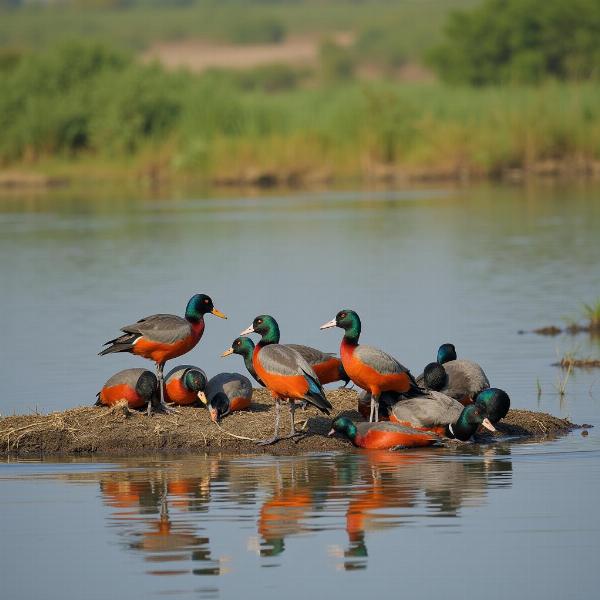Understanding the meaning of “sanctuary” in Hindi is crucial for anyone interested in Indian wildlife, conservation efforts, and cultural nuances. The word “sanctuary” carries a sense of protection and refuge, mirroring its English counterpart. This article delves into the various Hindi terms for “sanctuary,” exploring their subtle differences and contextual usage. We’ll also examine the significance of sanctuaries in Indian culture and their role in preserving the country’s rich biodiversity.
Abhayaranya: A Place of Fearlessness
The most common Hindi word for “sanctuary” is “अभयारण्य” (abhayaranya). This term beautifully encapsulates the essence of a sanctuary. “Abhaya” means “fearless” or “without fear,” while “aranya” means “forest” or “wilderness.” Thus, abhayaranya literally translates to a “forest without fear,” a place where animals can thrive without the threat of human intervention. This word reflects the deep-rooted respect for nature prevalent in Indian tradition. What does this mean for the animals residing within these protected spaces? It signifies a commitment to their safety and wellbeing, ensuring their survival for generations to come.
Other Hindi Terms for Sanctuary
While abhayaranya is widely used, other terms exist that further nuance the concept of a sanctuary. “पक्षी विहार” (pakshi vihar) specifically refers to a “bird sanctuary,” a haven for avian species. “वन्यजीव अभयारण्य” (vanyajeev abhayaranya) is a more formal term for “wildlife sanctuary,” emphasizing the protection of all wildlife within its boundaries. The term “dweep” (द्वीप), meaning island, can sometimes refer to a sanctuary, especially when it is isolated and provides a unique habitat for certain species. For instance, if you’re looking for information about the meaning of “dweep,” you can visit our page on dweep meaning in hindi.
The Cultural Significance of Sanctuaries in India
Sanctuaries are deeply intertwined with Indian culture and spirituality. Many sanctuaries are located near sacred groves or temples, highlighting the interconnectedness of nature and faith. The concept of ahimsa, non-violence, further reinforces the importance of protecting all living beings, contributing to the reverence for sanctuaries.
The Role of Sanctuaries in Conservation
Sanctuaries play a vital role in biodiversity conservation. They provide a safe haven for endangered species like the cheetal (चीतल), protecting them from poaching and habitat loss. You can learn more about the cheetal on our dedicated page: cheetal meaning in hindi. Sanctuaries also help maintain ecological balance, contributing to the overall health of the environment. This preservation is crucial in the face of increasing threats like climate change and habitat destruction.
How do Sanctuaries differ from National Parks?
While both sanctuaries and national parks aim to protect wildlife, they differ in their level of protection. National parks have stricter regulations regarding human activity, whereas sanctuaries allow for certain activities like grazing and the collection of minor forest products. Understanding this distinction helps appreciate the specific role each plays in conservation. For example, understanding the concept of buffer zones around protected areas is crucial. Learn more about this on our page buffer zone meaning in hindi.
What is the importance of Bird Sanctuaries?
Bird sanctuaries are essential for protecting diverse avian species, particularly migratory birds that travel long distances. These designated areas offer safe nesting grounds and food sources, contributing significantly to avian conservation. If you’re keen to learn more about the Hindi term for “bird sanctuary,” check out our article on bird sanctuary meaning in hindi.
 Migratory Birds in Indian Bird Sanctuary
Migratory Birds in Indian Bird Sanctuary
Conclusion
Understanding the meaning of sanctuaries in Hindi offers a deeper appreciation for India’s commitment to wildlife conservation and its cultural reverence for nature. From the widely used abhayaranya to specialized terms like pakshi vihar, each word reflects the multifaceted approach to protecting India’s rich biodiversity. These sanctuaries are not merely protected areas; they are vital components of India’s ecological and cultural heritage. The conservation efforts within these sanctuaries contribute significantly to ensuring the survival of numerous species, reminding us of our responsibility towards protecting the natural world.
FAQ
- What is the main difference between a sanctuary and a national park? Sanctuaries allow certain human activities while national parks have stricter regulations.
- What is the Hindi word for bird sanctuary? Pakshi vihar (पक्षी विहार) is the Hindi word for bird sanctuary.
- Why are sanctuaries important for conservation? Sanctuaries provide safe havens for endangered species and help maintain ecological balance.
- What does abhayaranya mean? Abhayaranya means “forest without fear,” a place where animals can live without human threat.
- How are sanctuaries connected to Indian culture? Many sanctuaries are located near sacred sites, highlighting the connection between nature and spirituality in Indian culture.
- Are there sanctuaries for specific animal groups? Yes, for example, pakshi vihar is specifically for birds.
- Where can I find more information on extinct species in Hindi? Visit our page on extinct species meaning in hindi.
About Meaning-Hindi.in
Meaning-Hindi.in is your premier destination for professional Hindi translation services. We offer a comprehensive suite of language solutions, including business and commercial document translation, certified and legal document translation, technical and user manual translation, website and software localization, educational and academic document translation, express translation, and specialized industry translation. Need accurate and reliable Hindi translations? Contact us today at [email protected] or call us at +91 11-4502-7584. Meaning-Hindi.in is committed to delivering high-quality language services tailored to your specific needs.